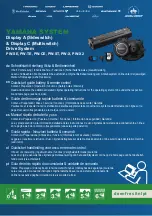
Learning Advanced Features
234
•
For sensorless-2 mode operation, the motor-rated capacity must match the inverter
’
s rated
capacity. If the inverter capacity is too large for the installed motor, run the motor in V/F mode.
•
Sensorless-2 mode does not support multiple motor control (MMC) features. Do not connect
multiple motors to one inverter that is operating in sensorless-1 mode.
Sensorless-2 Vector Control
–
Details
Code
Description
DRV-14 Motor Capacity,
BAS-11 Pole Number,
BAS-12 Rated Slip,
BAS-13 Rated Curr,
BAS-15 Rated Volt,
BAS-16 Efficiency
Motor parameter information is required for sensorless-2 vector control
mode.
Check the motor
’
s rating plate for the motor capacity and other
performance related information, set the relevant parameters, and then
run auto tuning at BAS-20.
BAS-20 Auto Tuning
After setting all the parameter values (DRV-14 Motor Capacity, BAS-11
Pole Number, BAS-12 Rated Slip, BAS-13 Rated Curr, BAS-15 Rated Volt,
and BAS-16 Efficiency), perform a rotating auto tuning.
To perform rotating auto tuning
, separate the load from the motor
axis, and set BAS-20 to
“
1 (ALL)
”
. The motor stator resistance (Rs),
leakage inductance (Lsigma), stator inductance (Ls), no-load current
(Noload Curr), and rotor time constant (Tr) are saved in BAS-21, BAS-22,
BAS-23, BAS-14, and BAS-24, respectively.
CON-20 SL2 G View Sel
Set CON-20 to
“1
(Yes)
”
to view various medium speed* gains (CON-23
ASR-SL P Gain2, CON-24 ASR-SL I Gain2, CON-27 Observer Gain2, CON-
28 Observer Gain3, CON-31 S-Est P Gain2, and CON-32 S-Est I Gain2) for
user configuration. These parameters are not visible if CON-20 is set to
“
0 (No)
”
.
*Medium speed: A speed range that is approximately 50% of the base
frequency.
CON-21 ASR-SL P Gain1,
CON-22 ASR-SL I Gain1
Sets the speed controller proportionately and integral gain values for
sensorless-2 vector control.
The P-gain is proportionate to speed deviation. Increasing the P-gain
increases torque output and immediately eliminates speed deviation.
The I-gain is an integral gain which represents the time (ms) until the
torque output is made under a steady speed deviation. Decreasing the
I- gain can eliminate the speed deviation faster.
After setting the speed controller gain values, observe the changes and
fine-tune the values to improve the speed control waveforms. Note that
vibration may result if the set P-gain value is too large or the set I-gain
value is too small. If oscillation is observed in the waveform, first
increase the I-gain, and then increase the P-gain to find the optimal
Summary of Contents for SV-iS7 Series
Page 17: ......
Page 114: ...Peripheral Devices 97 Group 2 ...
Page 115: ...Peripheral Devices 98 Group 3 ...
Page 116: ...Peripheral Devices 99 Group 4 ...
Page 159: ...Basic Functions 142 Code Description V1 Quantizing ...
Page 465: ...Safety Funtion STO Safe Torque Off 448 14 2 1 Safety Function Wiring Diagram ...
















































